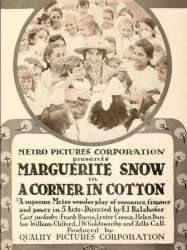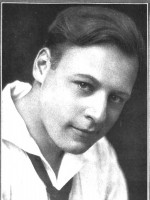Fred J. Balshofer is a Actor, Director, Scriptwriter and Producer American born on 2 november 1877 at New York City (USA)

Fred J. Balshofer (November 2, 1877 – June 21, 1969) was an American pioneer silent film director, producer, screenwriter, and cinematographer.
Hired by Adam Kessel of the New York Motion Picture Company, in 1909 Fred Balshofer directed his first film called "Disinherited Son's Loyalty" on which he also served as cinematographer. That same year he directed Davy Crockett – In Hearts United, believed to be the first Davy Crockett movie ever made. Filming at the time centered mainly around facilities and locations in the Fort Lee, New Jersey area but within a few years Balshofer moved to the West Coast as General Manager of the New York Motion Picture Company, directing western films for their subsidiary, Bison Motion Pictures until Thomas H. Ince joined the studio. By 1916, Balshofer had left Kessel's operation to become president and general manager of the Yorke-Metro studios at 1329 Gordon St. in Hollywood. In the 1920s, he produced and directed films for his own production company.
During his career, Fred Balshofer produced and/or directed more than eighty silent films then, after an unsuccessful attempt at age fifty directing a Spanish language talkie, he spent the better part of his remaining career working as a studio executive. In 1967 he teamed up with friend and acclaimed cinematographer Arthur C. Miller to write a significant book on the film industry under the title "One Reel a Week." Published by the University of California Press, the book chronicled the early history of the motion picture industry, including the shift in location and facilities from the East Coast to Southern California and the rise of the western film genre.
Source : Wikidata
Fred J. Balshofer

- Infos
- Photos
- Best films
- Family
- Characters
- Awards
Nationality USA
Birth 2 november 1877 at New York City (USA)
Death 21 june 1969 (at 91 years) at Calabasas (USA)
Birth 2 november 1877 at New York City (USA)
Death 21 june 1969 (at 91 years) at Calabasas (USA)
Biography
Born in New York City, Balshofer became interested in the photography business at an early age and eventually worked as a stereoscopic-slide photographer. Drawn to the fledgling motion picture business, from 1905 to 1908 he worked at Lubin Studios in Philadelphia.Hired by Adam Kessel of the New York Motion Picture Company, in 1909 Fred Balshofer directed his first film called "Disinherited Son's Loyalty" on which he also served as cinematographer. That same year he directed Davy Crockett – In Hearts United, believed to be the first Davy Crockett movie ever made. Filming at the time centered mainly around facilities and locations in the Fort Lee, New Jersey area but within a few years Balshofer moved to the West Coast as General Manager of the New York Motion Picture Company, directing western films for their subsidiary, Bison Motion Pictures until Thomas H. Ince joined the studio. By 1916, Balshofer had left Kessel's operation to become president and general manager of the Yorke-Metro studios at 1329 Gordon St. in Hollywood. In the 1920s, he produced and directed films for his own production company.
During his career, Fred Balshofer produced and/or directed more than eighty silent films then, after an unsuccessful attempt at age fifty directing a Spanish language talkie, he spent the better part of his remaining career working as a studio executive. In 1967 he teamed up with friend and acclaimed cinematographer Arthur C. Miller to write a significant book on the film industry under the title "One Reel a Week." Published by the University of California Press, the book chronicled the early history of the motion picture industry, including the shift in location and facilities from the East Coast to Southern California and the rise of the western film genre.
Usually with
Filmography of Fred J. Balshofer (9 films)
Actor

Directed by Fred J. Balshofer
Origin USA
Genres Crime
Actors Fred J. Balshofer
Roles Camera Person
Rating44%





Un crime est commis par un gorille échappé de sa cage. Des indices accusent un jeune homme, Jim. Il est jugé et condamné, mais Sherlock Holmes va découvrir que c'est l'animal qui est coupable et il arrive juste à temps pour empêcher l'exécution.
Director

The Isle of Love (1920)
, 50minutesDirected by Fred J. Balshofer
Origin USA
Genres Drama, Comedy
Themes Films about sexuality, LGBT-related films, Transgender in film, LGBT-related films, LGBT-related film, Cross-dressing in film
Actors Julian Eltinge, Rudolph Valentino, Frederick Ko Vert, Virginia Rappe, William Clifford, William Clifford
Rating53%





An island ("The Isle of Love"), run by a crazed-with-power duke, is in turmoil. The peasants plan a revolt, with two buddies, including Cliff (Julian Eltinge), planning to overthrow the corrupt Duke.

Paradise Garden (1917)
, 50minutesDirected by Fred J. Balshofer
Origin USA
Genres Comedy, Romantic comedy
Actors Harold Lockwood, Vera Sisson, Virginia Rappe, William Clifford, Lester Cuneo

A Corner in Cotton (1916)
Directed by Fred J. Balshofer
Origin USA
Genres Drama
Actors Marguerite Snow, William Clifford, Frank Bacon, Lester Cuneo, William Clifford, Helen Dunbar
A Corner in Cotton tells the story of Peggy Ainslee, the daughter of a wealthy New York cotton broker, and John Carter, the son of a Southern cotton mill owner. Peggy grows weary of society life and decides to help improve the lot of the poor by becoming involved with the Settlement movement. She later travels south to investigate working conditions at Carter’s cotton mill. Peggy manages to gain employment there, but soon attracts the unwanted advances of the mill foreman. John saves her from the would-be masher and the couple eventually fall in love. This becomes a problem with their fathers who had become business antagonist. In the end Peggy and John married after she foils her father’s attempt to ruin Carter by cornering the market in cotton and then persuades the two men to settle their differences.

The Doctor's Double (1912)
Directed by Fred J. Balshofer
Actors Harold Lockwood, Ann Little, Ethel Grandin, Leo D. Maloney, Richard Stanton

Directed by Fred J. Balshofer
Origin USA
Genres Crime
Actors Fred J. Balshofer
Rating44%





Un crime est commis par un gorille échappé de sa cage. Des indices accusent un jeune homme, Jim. Il est jugé et condamné, mais Sherlock Holmes va découvrir que c'est l'animal qui est coupable et il arrive juste à temps pour empêcher l'exécution.
Scriptwriter

The Isle of Love (1920)
, 50minutesDirected by Fred J. Balshofer
Origin USA
Genres Drama, Comedy
Themes Films about sexuality, LGBT-related films, Transgender in film, LGBT-related films, LGBT-related film, Cross-dressing in film
Actors Julian Eltinge, Rudolph Valentino, Frederick Ko Vert, Virginia Rappe, William Clifford, William Clifford
Roles Writer
Rating53%





An island ("The Isle of Love"), run by a crazed-with-power duke, is in turmoil. The peasants plan a revolt, with two buddies, including Cliff (Julian Eltinge), planning to overthrow the corrupt Duke.
Producer

The Second in Command (1915)
Directed by William Bowman
Origin USA
Genres Drama
Actors Francis X. Bushman, Marguerite Snow, William Clifford, Lester Cuneo, Helen Dunbar
Roles Producer
 Connection
Connection





